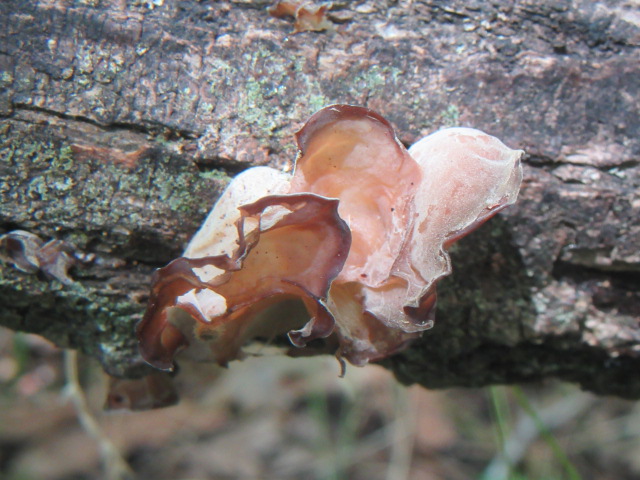
Auricularia americana (Jelly Tree Ear) at 2:22 PM on 6-26-22, #896-9.
Hello everyone! I hope this post finds you all doing well. It has been hot this past week. It is 99° F as I am starting to write this post. There is rain in the forecast for next week so hopefully, the temps will cool off a bit.
I had an interesting walk in the hayfield on June 26, just a couple of days before the hay was cut. It was kind of difficult to walk in the tall grass, but I was on a mission and needed to get to the back of the farm.
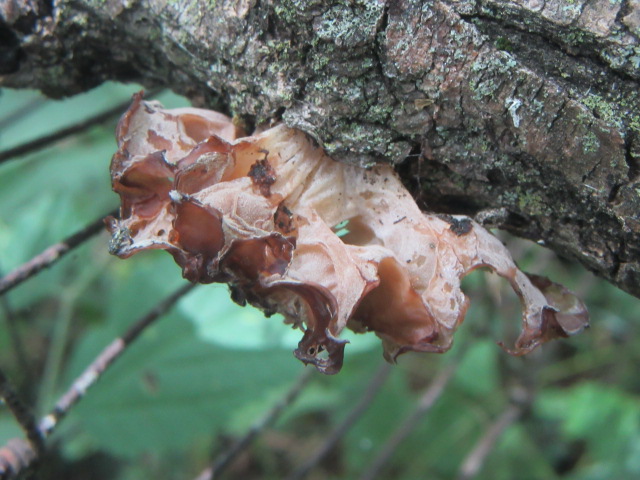
Auricularia americana (Jelly Tree Ear) on 6-26-22, #896-10.
I made my way through the trees in an area north of the chicken house to get to the pasture. I ran across a couple of Auricularia americana (Jelly Tree Ear) on a limb that had fallen. I have seen these before and they are very weird and kind of slimy.
I did a little reading on the MushroomExpert.Com and found out a few things… There are several species of jelly fungi (even in other genera) that differ somewhat in characteristics. The issue is “this species is NOT actually Auricularia americana… Auricularia americana grows on conifers, NOT deciduous trees… You can click on the link above to get the whole story.
Interestingly, it was recently discovered there are several genetically distinct species of Auricularia in the United States but there was a snag in naming them. As with other plants, there are strict rules that apply when naming new species. New species of fungi have to be registered online and given an identifier number. When submitting their publication about the new species, they didn’t include the identifier number, so their publication was invalid…
Hmmm… That was in 2015, seven years ago. Did they resubmit the publication again with the correct numbers? It’s like watching a series on TV and being left hanging in the end!!!
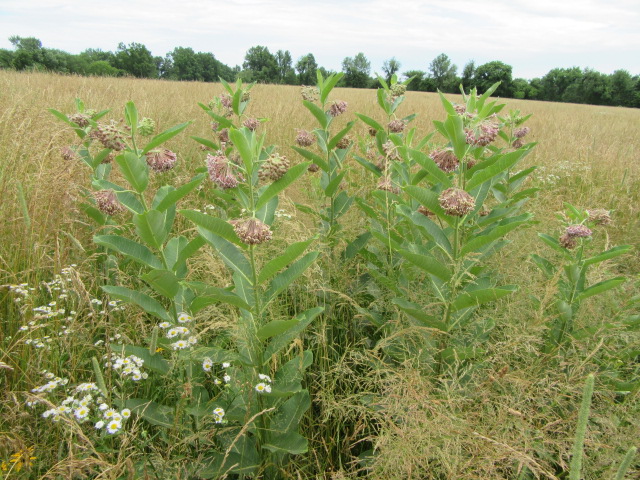
Asclepias syriaca (Common Milkweed) on 6-26-22, #896-5.
By 2:32, I had made my way to a nice group of Asclepias syriaca (Common Milkweed). There are plenty of them here on the farm, as I have probably mentioned before, and are hard to miss because of their height.
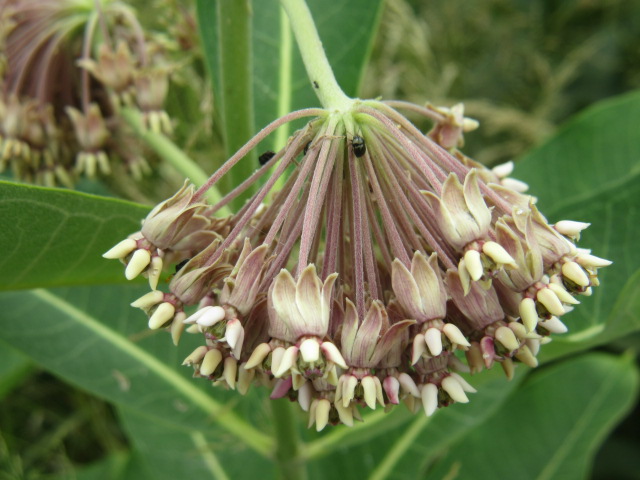
Asclepias syriaca (Common Milkweed) on 6-26-22, #896-7.
There is always A LOT of activity on milkweed. Not only on their flowers but sometimes on their leaves as well. Milkweed plants serve our ecosystem quite well. More about those little black bugs farther down…
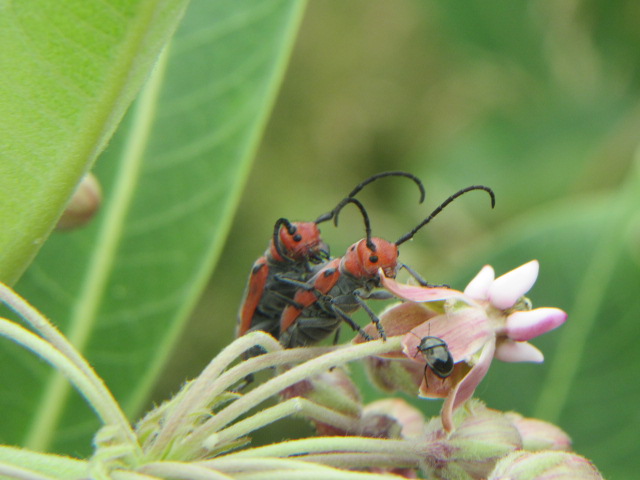
Tetraopes tetrophthalmus (Red Milkweed Beetle) on 6-26-22, #896-28.
Ummm… I was taking photos of the flowers, minding my own business, when a pair of Tetraopes tetrophthalmus (Red Milkweed Beetle) appeared. She started to blush and he said, “Do you mind?” I’m not sure if he was talking to me or the other bug…
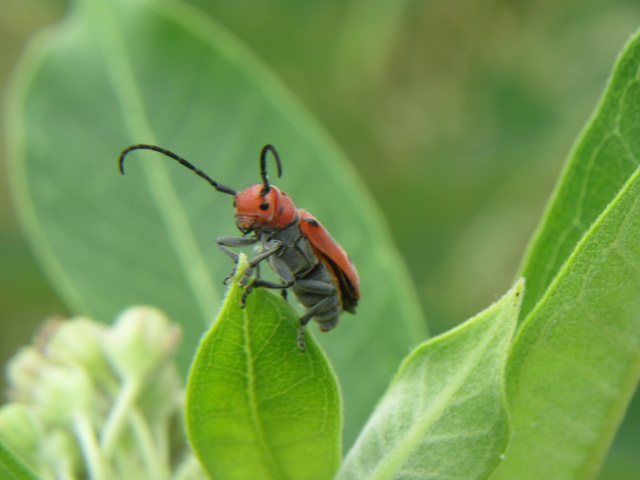
Tetraopes tetrophthalmus (Red Milkweed Beetle) on 6-26-22, #896-29.
I moved to a different plant and found another one. I was trying to get good photos of its back, but these guys move rather quickly. I did some reading on several websites about this critter and found out it is very interesting. Interesting facts include:
The genus and species names mean “four-eyes” because their antennas actually separate their eyes, giving them four eyes instead of two.
Tetraopes tetrophthalmus prefers Asclepias syriaca (Common Milkweed) over other milkweed species. Other members of the genus are also generally host-specific and prefer other milkweed species.
Adult Red Milkweed Beetles feed on the plant’s leaves, buds, and flowers. When feeding on the leaves, they cut a slit in the veins and feed on the sap as it runs out of the cut. They have to wipe their mouths on the leaves so their mouth won’t get gummed up… The toxins from the sap is absorbed into the beetles, which also makes them toxic to predators. I read where the toxins give the beetles their color, which is a warning to predators that they are distasteful and toxic.
Females lay clutches of reddish eggs toward the base of the plants and the larvae burrow into the soil and feed on the roots. Perhaps depending on when the eggs are laid, some information says they hibernate in the cells they make around the roots.
If they are startled, they make a shrill noise but they purr when interacting with other beetles… Hmmm…
Red Milkweed Beetles only live for one month…
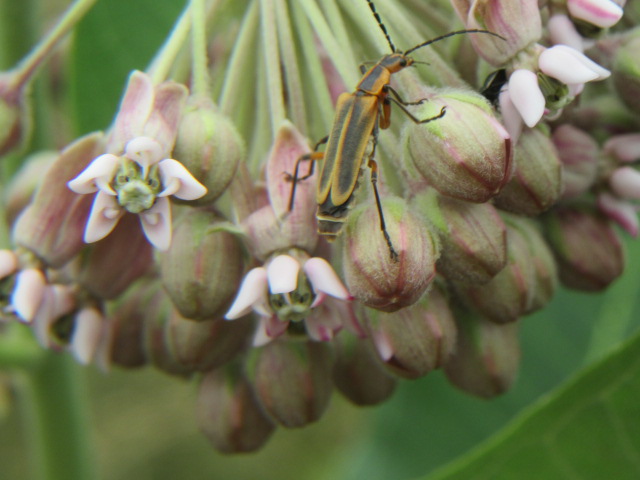
Chauliognathus marginatus (Margined Leatherwing Beetle) on 6-26-22, #896-11.
Then I ran into a very busy Chauliognathus marginatus (Margined Leatherwing Beetle) which didn’t want to stand still either. Another common name is Margined Soldier Beetle. To its right, hiding, is another one of those small black bugs… These insects are beneficial pollinators and they feed on nectar, pollen, and small insects such as aphids. Their larvae are also vicious predators. The coloration of the adults is quite variable. These are a farmer’s and gardener’s friends, so if you see them in large numbers on your flowers, don’t worry. They have their own mission and they will not damage your plants.
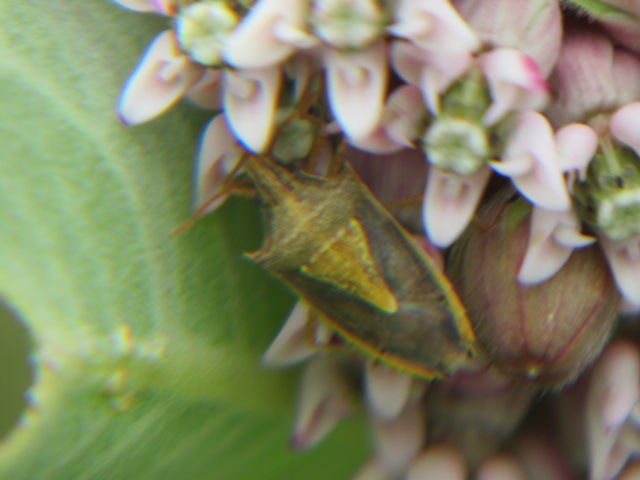
Oebalus pugnax (Rice Stink Bug) on 6-26-22, #896-19.
Then, I ran this Oebalus pugnax (Rice Stink Bug)… I have identified several species of stink bugs here on the farm that look similar, but this one was different. This bug IS NOT a friend, especially for farmers who grow rice, sorghum, wheat, etc. They feed on wild grasses and then migrate to fields to do their damage. They feed on the endosperm of the seed leaving an empty shell or shriveled kernels.
Adults overwinter near the ground in grass then lay their eggs in clusters of 10-30 in double rows on the leaves or seed heads of grasses. The nymphs molt 5 times to become adults in 18-50 days, depending on temperature. They can produce 2 to 5 generations per year…
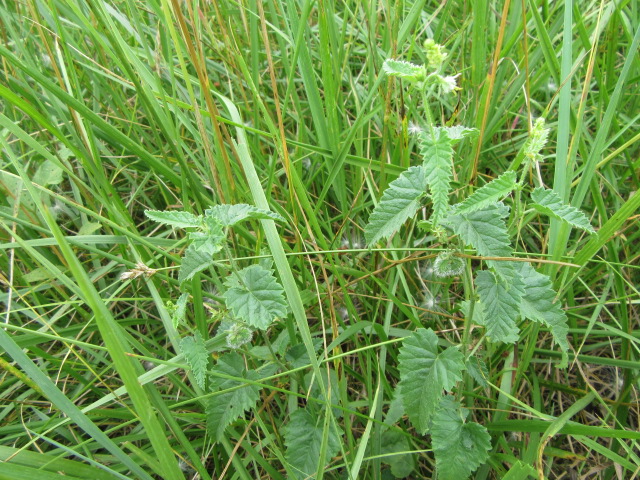
Tragia betonicifolia (Betony-Leaf Noseburn) on 6-26-22, #896-30.
I moved on a little northeast from the milkweed and stumbled across another plant I hadn’t seen before. I took quite a few photos and uploaded the one above on iNaturalist to get an idea. Its top suggestion was Tragia urticifolia (Nettleleaf Noseburn), the second was Tragia ramosa (Desert Noseburn), the third was Rhynchosida physocalyx (Beaked Sida), then they went downhill after that. The first was a possibility but not the other two.
I checked on the Missouri Plants website and it wasn’t on the list but three other species were. The only one I saw that looked close (from the photos) was Tragia betonicifolia (Betony-Leaf Noseburn). At the bottom of the page it says T. urticifolia closely resembles the species but isn’t found in Missouri. I checked the maps on Plants of the World Online, Flora of North America, USDA Plants Database, and BONAP and all agreed T. urticifolia isn’t in Missouri. Well, one would have been enough but I had to try. 🙂 The maps do show Tragia betonicifolia is in Missouri but not in Pettis County where I live. However, the species has been found in Henry County which is across the street, and Johnson County which is only a few miles away. How many times has that happened? Too many to count… Even the tree frogs that like my house are a species not found in Pettis County but they are in Henry, like 100′ away. 🙂
Even though I had my doubts the species was Tragia urticifolia, I went ahead and submitted the observation as such with seven photos. The more detailed photos you have the better especially when you are in doubt… Oddly, no one agreed or suggested a different ID even after a month (when I am writing this). I decided I would go back and do more exploring… There were only two observations of Tragia urticifolia posted in Missouri and one was mine. However, there were seven for T. betonicifolia and three were from botanists. SO, I sent them a message along with a link to my observation. One replied the next day and said “…I hate basing IDs on geography alone, so I keyed it out to confirm the ID. Your plant is T. betonicifolia. They are difficult to distinguish from photos (keying requires an angle of the flowers that shows the right character), so it doesn’t surprise me that iNat’s algorithm had trouble with it.” I can certainly understand that… Out of 909 observations (402 different species) I have submitted to iNaturalist, they have only been a little off a few times. I think that is pretty darn good!

Tragia betonicifolia (Betony-Leaf Noseburn) on 6-26-22, #896-34.
Tragia species are monoecious and produce separate staminate (male) and pistillate (female) flowers on the same plant but in an odd sort of way. Unlike members of the Asteraceae, for example, which produce male and female flowers on the same flower. They produce a single pistillate flower at the base of the inflorescence (floral stem), then a raceme of up to 30 staminate flowers. Compared to other photos I have seen online, the inflorescence in the above photo is, ummm, somewhat short and apparently, the pistillate flower has already been fertilized…
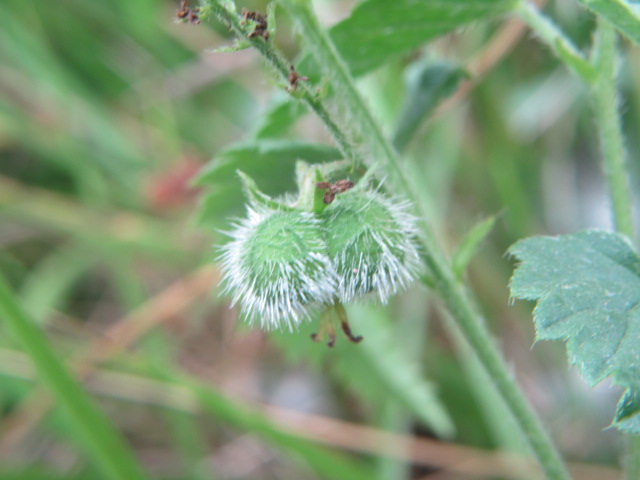
Tragia betonicifolia (Betony-Leaf Noseburn) on 6-26-22, #896-36.
The above photo was taken of a different inflorescence where you can see the fuzzy fruit that has started to develop from the ovary of the pistillate flower. Above the fruit, you can see the remains of a few staminate flowers. There were more staminate flowers at the top of the inflorescence but those photos were all blurry… By the time I went through the photos, the hayfield was cut along with this plant… GEEZ! You know what they say? “He who hesitates…” The ovaries have three large carpels…
OH, I better not forget to mention that Tragia species are members of the spurge family Euphorbiaceae. They are covered with STINGING hairs that are said to cause intense pain. One website said as much pain as you could ever have. When I read that, I was reminded of my kidney stones…
if you want to read more about this species, the Missouri Plants website has some good photos with technical descriptions. The Arkansas Native Plant Society also has great photos and a lot of very good information.
Moving right along…
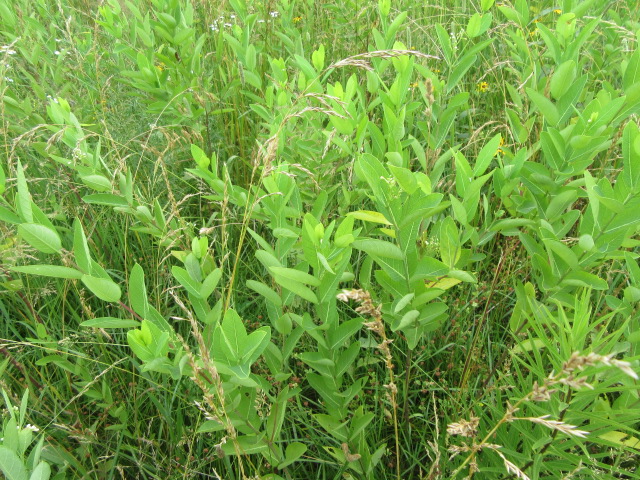
Apocynum cannabinum (Hemp Dogbane) on 6-26-22, #896-1.
I ran across a good-sized colony of Apocynum cannabinum (Hemp Dogbane), which is beginning to be an old story. I first identified this species from a single plant I found in the south side of the main hayfield in 2020. Since then, they have spread like you wouldn’t believe! In 2021, I found one along the road in front of the garden so I let it grow… After the hay was cut in the south hayfield in 2021, a HUGE patch came up toward the front. This year, the single plant along the road in front of the garden turned into a HUGE colony… GEEZ!!! I think this species could be somewhat invasive…
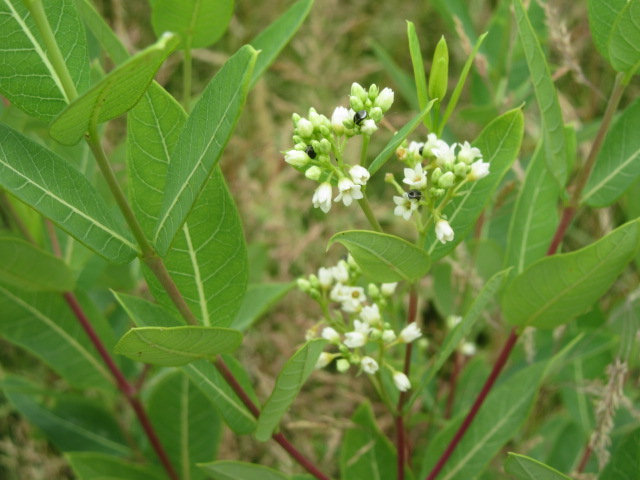
Apocynum cannabinum (Hemp Dogbane) flowers on 6-26-22, #896-4.
They produce LOTS of flowers. Ummm… There are those darn black bugs AGAIN… Maybe we should have a closer look…
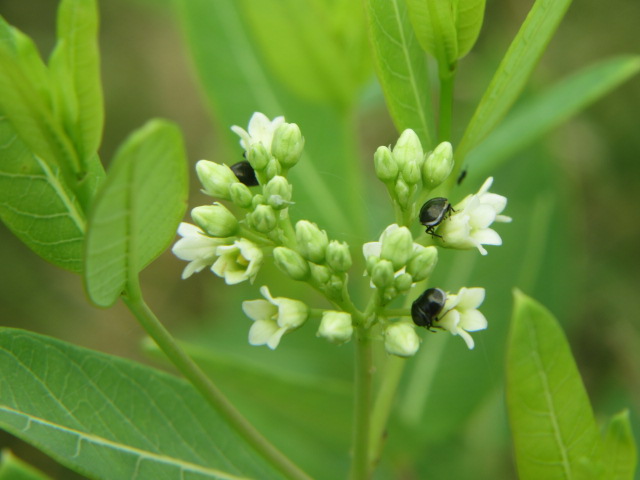
Corimelaena pulicaria (Black Bug) on 6-26-22, #896-13.
Well, I took several photos to get a good one… I uploaded the photos on iNaturalist and they listed several suggestions of species seen nearby. At first, I thought they were possibly Sehirus cinctus (White-Margined Burrower Bug), so I selected that name on the list and went with it hoping someone would have an idea. The color looked similar, but so did the other suggestions. Within no time, a member suggested the genus Corimelaena, a member of the family Thyreocoridae (Ebony Bugs)… So I checked the genus out and found a website that listed several species and what plants they preferred. Low and behold, it said Corimelaena pulicaria feeds on Apocynum cannabinum (among other plants). So, I went with that species and changed the name on the observation. Even though iNaturalist gives the common name Black Bug, many websites don’t even give a common name. There are many species of “Black”, “Ebony”, and “Negro” bugs in several genera that look exactly alike to me… I didn’t feel like catching one looking at this and that part with a magnifying glass… Looking again, they could be Corimelaena obscura… I think I will stop thinking about it for now and just stick with Corimelaena pulicaria or maybe just some kind of a Thyreocoridae. Well, since I can’t pronounce that either, how about just a black bug…
I went on the back of the pond AGAIN to check on the Calico and Ontario Asters which basically looked the same as they did a month earlier only a little taller… Nothing exciting to report.
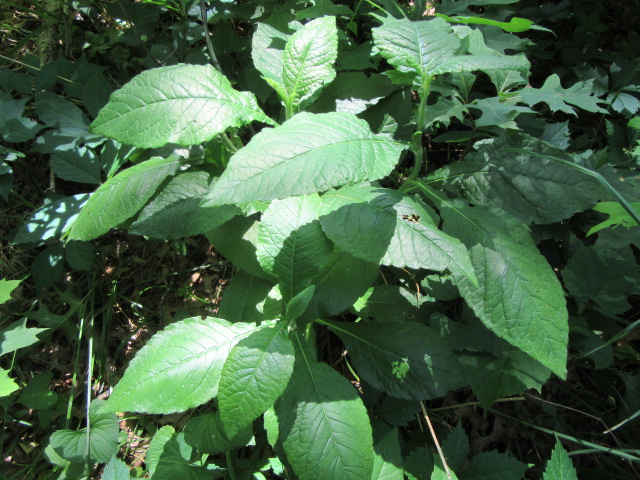
Elephantopus carolinianus (Leafy Elephant’s Foot) on 6-26-22, #896-18.
I walked over to where the Elephantopus carolinianus (Leafy Elephant’s Foot) are growing and they were looking GREAT! I don’t remember if I mentioned it before, but there are two small colonies. One behind the pond and one under the persimmon tree. The plants under the persimmon tree are much easier to get to.
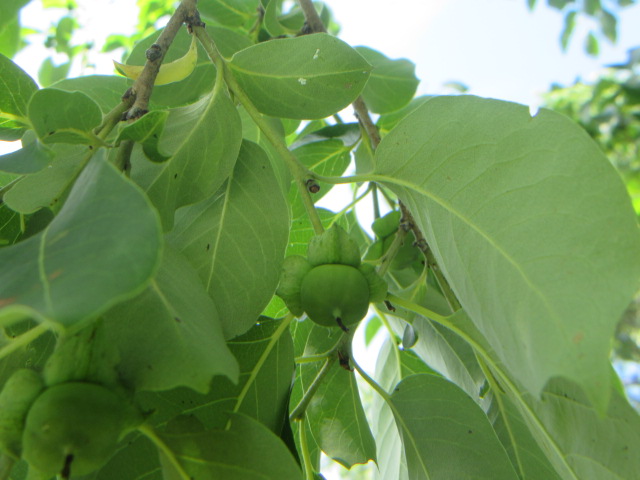
Diospyros virginiana (American Persimmon) on 6-26-22, #896-17.
The persimmons are coming along nicely…
Time has sure flown by The next post will be more or less up to date.
Until then, be safe and stay positive. Always be thankful and try to GET DIRTY.